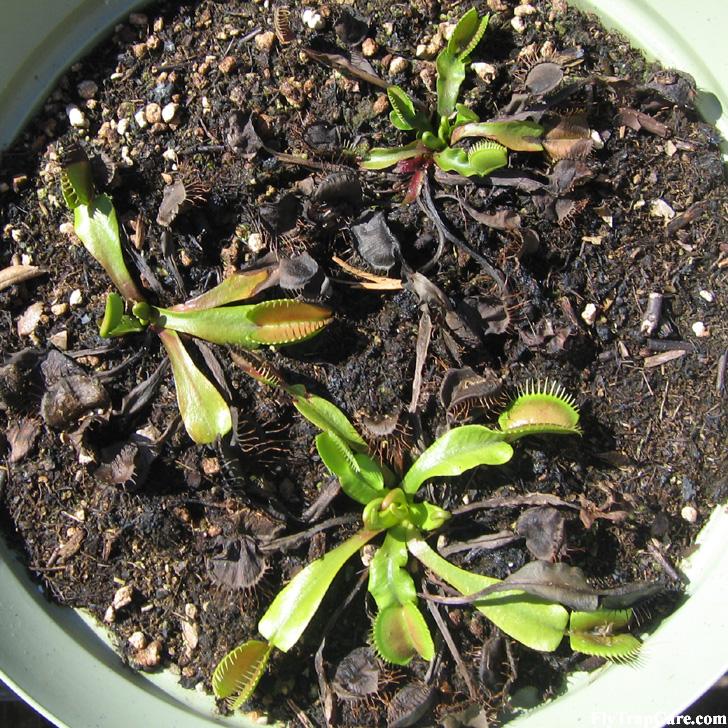Venus flytraps are notoriously hard to care for. However, their reputation for being challenging to grow is somewhat unwarranted. There are only a few, but quite strict, rules to follow for basic care of a Venus flytrap.
Follow these basic Venus flytrap care techniques and you will have beautiful plants for many years!

There are really only four things Venus flytrap plants require to stay healthy:
- Sunlight: At least four hours of direct sunlight a day (i.e. full sun)
- Water: rain, distilled, or reverse osmosis water only
- Soil: Nutrient poor soil such as peat moss or sphagnum moss and a pot with good drainage
- Dormancy: A yearly dormancy period in the winter months

Light for Venus flytraps
Venus flytraps require a lot of light. They should receive at least 4 hours of direct sunlight a day with 6 to 8 hours being ideal. It is best to grow your Venus flytrap plant outside where it can get plenty of sun and catch its own food.
It isn’t necessary to feed a Venus flytrap anything other than sunlight and water. If you do choose to feed it, feed it only insects and at most only a few insects a month. Feeding a Venus flytrap, or growing it somewhere that it can catch its own food, can help it grow much more quickly.

Water for Venus flytraps
Venus flytraps need clean water. Most tap water will not be suitable for watering them due to the high mineral content. It is best to use distilled water, rainwater, or reverse osmosis water.
Venus flytraps need water with a TDS (total dissolved solids) measurement of 50 ppm (parts per million) or less. In order to get this, you will probably need to use distilled water or reverse osmosis water or rainwater.
If desired, you can use a TDS meter to test your tap water and see if it is usable. Growers often use water with a TDS measurement between 50 ppm and 100 ppm. However, this requires regular flushing and repotting to prevent mineral buildup in the soil.
Their soil should be kept damp at all times. They prefer to have soil that is not soaking wet all the time. However, the soil must never be allowed to dry out. Allow the soil to dry to the point where it is just damp then thoroughly water the plant until the soil is completely soaked. Then allow the soil to dry to the point of being barely damp again before repeating the process.
Many growers set the Venus flytrap’s pot in a tray of water for 30 to 45 minutes and allow the soil to soak up as much water as it can hold. Alternatively, they do enjoy being watered from the top. Pouring water over the top of the pot and allowing it to soak into the soil will carry some nitrogen down into the soil and aerate the roots.
Either way, when watering a Venus flytrap, ensure that the soil is thoroughly and evenly soaked all the way through. Then allow the soil to dry to the point where it is barely damp before watering again.

Soil for Venus flytraps
If your Venus flytrap needs to be repotted, for Venus flytrap soil you should use a combination of peat moss and perlite. Many growers use a 50:50 mix of peat moss and perlite or peat moss and horticultural grade silica sand. Pure peat moss works well also.
We’ve been growing Venus flytraps for over a decade now and have used many different soil types. As of the last few years, we’ve preferred growing in New Zealand long-fiber sphagnum moss. The flytraps grow more quickly and have few health issues when grown in New Zealand long-fiber sphagnum moss as long as they are repotted annually in the spring.
Venus flytraps aren’t terribly picky about the soil or soil mixture they grow in as long as it is some form of long-fiber sphagnum or sphagnum peat moss which ensures that the media is nutrient-poor. Using perlite helps keep their soil aerated which allows for healthy root growth that leads to larger, more robust plants.
Avoid using vermiculite because it often contains minerals that will slowly poison Venus flytraps. Unglazed clay pots shouldn’t be used for pots because the minerals in the clay can seep into the soil and eventually cause harm to a Venus flytrap. For this reason, it’s best to use plastic pots.
We prefer pots that are at least four inches deep because they provide enough room to accommodate the roots well. The deeper the better!
Dormancy for Venus flytraps
When summer is over and fall has started, it is time to think about providing dormancy for your Venus flytrap. Without a dormancy period, your plant’s health will start to decline and it will eventually die.
Venus flytraps go dormant naturally when given natural sunlight and seasonal changes. You can read more about your options for providing dormancy on the Venus flytrap Dormancy page or in the Venus flytrap Dormancy FAQ section.
For more extremely detailed information about how to best take care of your Venus flytraps, be sure to see our Comprehensive Detailed Venus flytrap Care Information article.

Questions? Join the FlytrapCare Forums
There is an active and friendly community of growers here on the FlytrapCare Forums. Join us!
https://www.flytrapcare.com/phpBB3/
Looking to grow more Venus flytraps?
Be sure to check out FlytrapStore.com for a huge selection of Venus flytraps for sale.
